Movement Control Tests For Lumbar Spine: Difference between revisions
Carin Hunter (talk | contribs) No edit summary |
No edit summary |
||
| (10 intermediate revisions by 3 users not shown) | |||
| Line 2: | Line 2: | ||
== Introduction == | == Introduction == | ||
A specific subgroup of individuals with low back pain are know to have movement control dysfunction.<ref name=":4">Lehtola V, Luomajoki H, Leinonen V, Gibbons S, Airaksinen O. [https://bmcmusculoskeletdisord.biomedcentral.com/articles/10.1186/1471-2474-13-55 Efficacy of movement control exercises versus general exercises on recurrent sub-acute nonspecific low back pain in a sub-group of patients with movement control dysfunction. Protocol of a randomized controlled trial]. BMC Musculoskelet Disord. 2012 Apr 11;13:55. </ref> It has been found that there are significant differences in the ability of these individuals to actively control movements of their low back compared to individuals without pain.<ref name=":4" /> | |||
Luomajoki et al.<ref name=":1" /> conducted a study looking at various movement control tests.<ref name=":1" /> Participants performed a standardised test battery which included 10 active movement tests. Participants did not know the movement tests. Each movement was scored by four different physiotherapists. If a participant was able to improve a movement with instruction and correction, no movement dysfunction was indicated (tests<ref>Alrwaily M, Timko M, Schneider M, Stevans J, Bise C, Hariharan K, Delitto A. [https://academic.oup.com/ptj/article/96/7/1057/2864925 Treatment-based classification system for low back pain: revision and update.] Physical therapy. 2016 Jul 1;96(7):1057-66.</ref> are considered positive when an individual cannot perform them correctly even with cueing and demonstration<ref name=":0">Lehtola V, Luomajoki H, Leinonen V, Gibbons S, Airaksinen O. [https://link.springer.com/article/10.1186/s12891-016-0986-y Sub-classification based specific movement control exercises are superior to general exercise in sub-acute low back pain when both are combined with manual therapy: A randomized controlled trial.] BMC musculoskeletal disorders. 2016 Dec;17(1):1-9.</ref>). In the study by Luomajoki et al.<ref name=":1" /> "physiotherapists were able to reliably rate most of the tests in this series of motor control tasks as being performed correctly or not". | |||
This page explores six movement control tests selected by [https://members.physio-pedia.com/instructor/nick-rainey/ Dr. Nick Rainey] for his Considerations for Lumbar Assessment course.<ref name=":5">Rainey N. Considerations for Lumbar Assessment Course. Plus, 2023.</ref> They come from the following articles: | |||
* Luomajoki H, Kool J, De Bruin ED, Airaksinen O. [https://bmcmusculoskeletdisord.biomedcentral.com/articles/10.1186/1471-2474-8-90 Reliability of movement control tests in the lumbar spine.] BMC musculoskeletal disorders. 2007 Dec;8(1):1-1.<ref name=":1" /> | |||
* Meier R, Emch C, Gross-Wolf C, Pfeiffer F, Meichtry A, Schmid A, Luomajoki H. [https://bmcmusculoskeletdisord.biomedcentral.com/articles/10.1186/s12891-021-04269-7 Sensorimotor and body perception assessments of nonspecific chronic low back pain: a cross-sectional study.] BMC Musculoskeletal Disorders. 2021 Dec;22(1):1-0.<ref name=":2">Meier R, Emch C, Gross-Wolf C, Pfeiffer F, Meichtry A, Schmid A, Luomajoki H. [https://bmcmusculoskeletdisord.biomedcentral.com/articles/10.1186/s12891-021-04269-7 Sensorimotor and body perception assessments of nonspecific chronic low back pain: a cross-sectional study.] BMC Musculoskeletal Disorders. 2021 Dec;22(1):1-0.</ref> | |||
===== 1. Waiter’s Bow: ===== | |||
'''Test protocol:''' Flexion of the hips in upright standing without movement (flexion) of the low back.<ref name=":1" /> | |||
'''Correct''': Forward bending of the hips 50° -70° without flexion of the low back.<ref name=":1">Luomajoki H, Kool J, De Bruin ED, Airaksinen O. [https://bmcmusculoskeletdisord.biomedcentral.com/articles/10.1186/1471-2474-8-90 Reliability of movement control tests in the lumbar spine.] BMC musculoskeletal disorders. 2007 Dec;8(1):1-1.</ref> | |||
'''Incorrect''': Flexion occurring in the low back prior to 50° of hip flexion.<ref name=":1" /> | |||
[[File:Waiters Bow.webp|center|alt=|thumb|685x685px|Waiter’s Bow<ref name=":1" />]] | |||
===== 2. Sitting Knee Extension: ===== | |||
'''Test protocol:''' Upright sitting with corrected lumbar lordosis; extension of the knee without movement (flexion) of low back <ref name=":1" /> | |||
'''Correct''': Upright sitting with lumbar lordosis; extension of the knee to within 50° of straight without movement of lower back.<ref name=":1" /> | |||
'''Incorrect''': Low back moving in flexion prior to within 50° of straight. <ref name=":1" />[[File:Sitting Knee Extension.webp|center|alt=|thumb|685x685px|Sitting Knee Extension<ref name=":1" />]] | |||
===== 3. Rocking Backwards: ===== | |||
'''Test protocol:''' Transfer of the pelvis backwards ("rocking") in a quadruped position keeping low back in neutral.<ref name=":1" /> | |||
'''Correct''': 120° of hip flexion without movement of the low back by transferring pelvis backwards.<ref name=":1" /> | |||
'''Incorrect''': Hip flexion causes flexion in the lumbar spine (typically the patient not aware of this).<ref name=":1" /> | |||
[[File:Rocking Backwards.webp|center|alt=|frame|Rocking Backwards<ref name=":1" />]] | |||
===== 4. Prone Lying Knee Flexion: ===== | |||
'''Test protocol:''' Actively in prone | |||
= | '''Correct''': Active knee flexion at least 90° without extension movement of the low back and pelvis.<ref name=":1" /> | ||
'''Incorrect''': Low back does not stay neutral, but moves into extension<ref name=":1" /> | |||
''' | [[File:Prone lying knee flexion.webp|center|alt=|frame|Prone Lying Knee Flexion<ref name=":1" />]] | ||
===== 5. Posterior Pelvic Tilt: ===== | |||
'''Test protocol:''' Actively in upright standing.<ref name=":1" /> | |||
''' | '''Correct''': Posterior pelvic tilt is done while standing by contracting the glute max while keeping the thoracic spine in neutral<ref name=":1" /> | ||
'''Incorrect''': Pelvis doesn't tilt or low back moves towards Ext./No gluteal activity/compensatory flexion in thoracic spine<ref name=":1" /> | |||
''' | [[File:Dorsal tilt of pelvis.webp|center|alt=|frame|Posterior Pelvic Tilt<ref name=":1" />]] | ||
===== 6. Single-leg Stance: ===== | |||
'''Test protocol:''' Patient’s feet 12cm apart. Use a 20cm ruler and hold it on a stable object with the middle of the ruler lined up with the patient's umbilicus.<ref name=":1" /> | |||
===== | |||
''' | |||
= | |||
'''Correct''': The patient’s umbilicus has <2cm difference side to side and <10 cm transfer on either foot.<ref name=":1" /> | |||
'''Correct''': | |||
'''Incorrect''': | '''Incorrect''': Lateral transfer of belly button >2cm difference side to side or > 10 cm in either direction .<ref name=":1" /> | ||
[[File:Single leg stance.webp|center|alt=|frame|Single-leg Stance<ref name=":1" />]] | |||
===== | == Research Discussion == | ||
Meier et al.<ref name=":2" /> evaluated whether there was a difference in movement control tests between people in pain and people without pain. For each positive test on the movement control tests, there was an odds ratio of 1.92 for the presence of chronic low back pain.<ref name=":2" /> In another study by Khodadad et al.<ref name=":3">Khodadad B, Letafatkar A, Hadadnezhad M, Shojaedin S. [https://journals.sagepub.com/doi/abs/10.1177/1941738119886854 Comparing the effectiveness of cognitive functional treatment and lumbar stabilization treatment on pain and movement control in patients with low back pain.] Sports Health. 2020 May;12(3):289-95.</ref> both cognitive functional treatment and lumbar stabilisation treatment improved pain and the movement control tests.<ref name=":3" /> The cognitive functional treatment group class sessions involved education, exercise, and relaxation/mindfulness. The stabilisation group received cues on how to properly control the spine during the following exercises which were held for three seconds: | |||
# Planks | |||
# Bridge | |||
# Bird-dog | |||
# Side bridge | |||
# Curl-up | |||
Lehtola at al.<ref name=":0" /> found that motor control exercises improved disability more than specific exercises at 3 and 12-month follow-ups. The motor control exercises were more “specific” instead of general. It is important to note that in this article, pictures are shown of each of the specific and general exercises used but the details of the specific exercises are unclear. However, the goal was to train movements in different positions and re-educate individuals on how to move and control the lumbar spine in relation to the hips and thoracic spine. The general exercises used were common core exercises. | |||
== | == Summary == | ||
Movement control tests "aren’t magical", but should be considered when there are no other larger impairments. They can be used as asterisk signs in some cases when sufficient progress isn’t being made. However, it is not clear how these tests/training compare to posterior chain strengthening or aerobic conditioning, both of which have been shown to improve low back pain. Further, biomedical impairments should always be graded against psychological and social “impairments”. <ref name=":5" /> | |||
When working with patients, you may find that some patients benefit from knowing which impairments you have found, but others may not. Always consider how much the patient needs to know about why they are in pain and the purpose of your interventions. "Too much information can be nocebic, but insufficient information can be frustrating. Good questioning will elicit patient concerns so you know what needs to be addressed."<ref name=":5" /> | |||
== References == | == References == | ||
Latest revision as of 23:18, 2 February 2023
Top Contributors - Carin Hunter, Rishika Babburu and Jess Bell
Introduction[edit | edit source]
A specific subgroup of individuals with low back pain are know to have movement control dysfunction.[1] It has been found that there are significant differences in the ability of these individuals to actively control movements of their low back compared to individuals without pain.[1]
Luomajoki et al.[2] conducted a study looking at various movement control tests.[2] Participants performed a standardised test battery which included 10 active movement tests. Participants did not know the movement tests. Each movement was scored by four different physiotherapists. If a participant was able to improve a movement with instruction and correction, no movement dysfunction was indicated (tests[3] are considered positive when an individual cannot perform them correctly even with cueing and demonstration[4]). In the study by Luomajoki et al.[2] "physiotherapists were able to reliably rate most of the tests in this series of motor control tasks as being performed correctly or not".
This page explores six movement control tests selected by Dr. Nick Rainey for his Considerations for Lumbar Assessment course.[5] They come from the following articles:
- Luomajoki H, Kool J, De Bruin ED, Airaksinen O. Reliability of movement control tests in the lumbar spine. BMC musculoskeletal disorders. 2007 Dec;8(1):1-1.[2]
- Meier R, Emch C, Gross-Wolf C, Pfeiffer F, Meichtry A, Schmid A, Luomajoki H. Sensorimotor and body perception assessments of nonspecific chronic low back pain: a cross-sectional study. BMC Musculoskeletal Disorders. 2021 Dec;22(1):1-0.[6]
1. Waiter’s Bow:[edit | edit source]
Test protocol: Flexion of the hips in upright standing without movement (flexion) of the low back.[2]
Correct: Forward bending of the hips 50° -70° without flexion of the low back.[2]
Incorrect: Flexion occurring in the low back prior to 50° of hip flexion.[2]
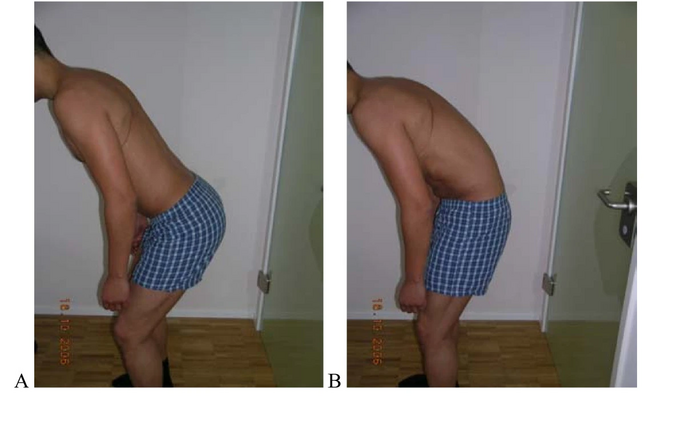
2. Sitting Knee Extension:[edit | edit source]
Test protocol: Upright sitting with corrected lumbar lordosis; extension of the knee without movement (flexion) of low back [2]
Correct: Upright sitting with lumbar lordosis; extension of the knee to within 50° of straight without movement of lower back.[2]
Incorrect: Low back moving in flexion prior to within 50° of straight. [2]
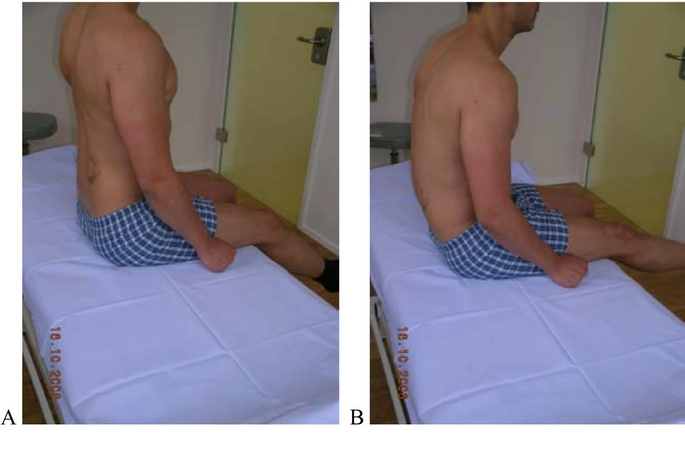
3. Rocking Backwards:[edit | edit source]
Test protocol: Transfer of the pelvis backwards ("rocking") in a quadruped position keeping low back in neutral.[2]
Correct: 120° of hip flexion without movement of the low back by transferring pelvis backwards.[2]
Incorrect: Hip flexion causes flexion in the lumbar spine (typically the patient not aware of this).[2]
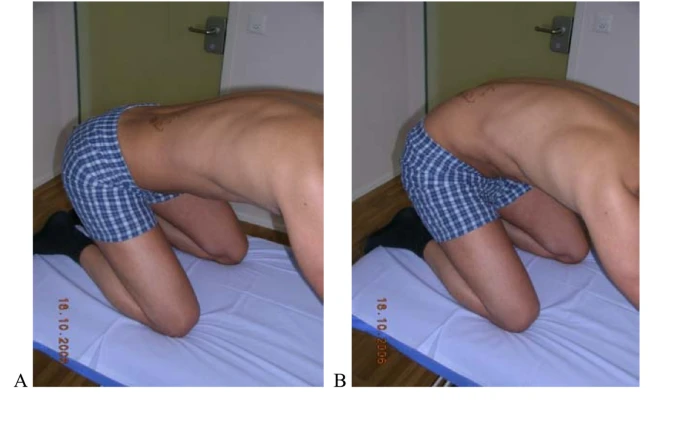
4. Prone Lying Knee Flexion:[edit | edit source]
Test protocol: Actively in prone
Correct: Active knee flexion at least 90° without extension movement of the low back and pelvis.[2]
Incorrect: Low back does not stay neutral, but moves into extension[2]
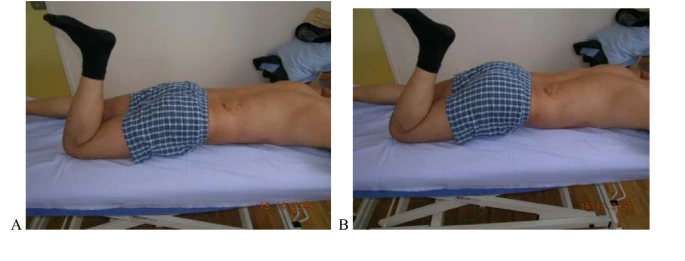
5. Posterior Pelvic Tilt:[edit | edit source]
Test protocol: Actively in upright standing.[2]
Correct: Posterior pelvic tilt is done while standing by contracting the glute max while keeping the thoracic spine in neutral[2]
Incorrect: Pelvis doesn't tilt or low back moves towards Ext./No gluteal activity/compensatory flexion in thoracic spine[2]
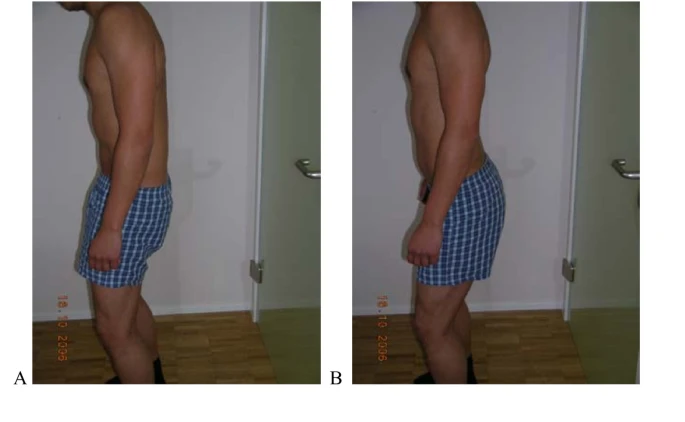
6. Single-leg Stance:[edit | edit source]
Test protocol: Patient’s feet 12cm apart. Use a 20cm ruler and hold it on a stable object with the middle of the ruler lined up with the patient's umbilicus.[2]
Correct: The patient’s umbilicus has <2cm difference side to side and <10 cm transfer on either foot.[2]
Incorrect: Lateral transfer of belly button >2cm difference side to side or > 10 cm in either direction .[2]
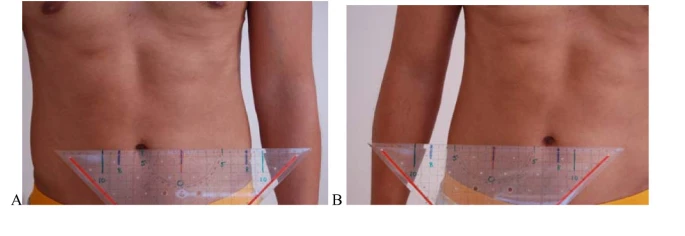
Research Discussion[edit | edit source]
Meier et al.[6] evaluated whether there was a difference in movement control tests between people in pain and people without pain. For each positive test on the movement control tests, there was an odds ratio of 1.92 for the presence of chronic low back pain.[6] In another study by Khodadad et al.[7] both cognitive functional treatment and lumbar stabilisation treatment improved pain and the movement control tests.[7] The cognitive functional treatment group class sessions involved education, exercise, and relaxation/mindfulness. The stabilisation group received cues on how to properly control the spine during the following exercises which were held for three seconds:
- Planks
- Bridge
- Bird-dog
- Side bridge
- Curl-up
Lehtola at al.[4] found that motor control exercises improved disability more than specific exercises at 3 and 12-month follow-ups. The motor control exercises were more “specific” instead of general. It is important to note that in this article, pictures are shown of each of the specific and general exercises used but the details of the specific exercises are unclear. However, the goal was to train movements in different positions and re-educate individuals on how to move and control the lumbar spine in relation to the hips and thoracic spine. The general exercises used were common core exercises.
Summary[edit | edit source]
Movement control tests "aren’t magical", but should be considered when there are no other larger impairments. They can be used as asterisk signs in some cases when sufficient progress isn’t being made. However, it is not clear how these tests/training compare to posterior chain strengthening or aerobic conditioning, both of which have been shown to improve low back pain. Further, biomedical impairments should always be graded against psychological and social “impairments”. [5]
When working with patients, you may find that some patients benefit from knowing which impairments you have found, but others may not. Always consider how much the patient needs to know about why they are in pain and the purpose of your interventions. "Too much information can be nocebic, but insufficient information can be frustrating. Good questioning will elicit patient concerns so you know what needs to be addressed."[5]
References[edit | edit source]
- ↑ 1.0 1.1 Lehtola V, Luomajoki H, Leinonen V, Gibbons S, Airaksinen O. Efficacy of movement control exercises versus general exercises on recurrent sub-acute nonspecific low back pain in a sub-group of patients with movement control dysfunction. Protocol of a randomized controlled trial. BMC Musculoskelet Disord. 2012 Apr 11;13:55.
- ↑ 2.00 2.01 2.02 2.03 2.04 2.05 2.06 2.07 2.08 2.09 2.10 2.11 2.12 2.13 2.14 2.15 2.16 2.17 2.18 2.19 2.20 2.21 2.22 2.23 2.24 2.25 2.26 Luomajoki H, Kool J, De Bruin ED, Airaksinen O. Reliability of movement control tests in the lumbar spine. BMC musculoskeletal disorders. 2007 Dec;8(1):1-1.
- ↑ Alrwaily M, Timko M, Schneider M, Stevans J, Bise C, Hariharan K, Delitto A. Treatment-based classification system for low back pain: revision and update. Physical therapy. 2016 Jul 1;96(7):1057-66.
- ↑ 4.0 4.1 Lehtola V, Luomajoki H, Leinonen V, Gibbons S, Airaksinen O. Sub-classification based specific movement control exercises are superior to general exercise in sub-acute low back pain when both are combined with manual therapy: A randomized controlled trial. BMC musculoskeletal disorders. 2016 Dec;17(1):1-9.
- ↑ 5.0 5.1 5.2 Rainey N. Considerations for Lumbar Assessment Course. Plus, 2023.
- ↑ 6.0 6.1 6.2 Meier R, Emch C, Gross-Wolf C, Pfeiffer F, Meichtry A, Schmid A, Luomajoki H. Sensorimotor and body perception assessments of nonspecific chronic low back pain: a cross-sectional study. BMC Musculoskeletal Disorders. 2021 Dec;22(1):1-0.
- ↑ 7.0 7.1 Khodadad B, Letafatkar A, Hadadnezhad M, Shojaedin S. Comparing the effectiveness of cognitive functional treatment and lumbar stabilization treatment on pain and movement control in patients with low back pain. Sports Health. 2020 May;12(3):289-95.






